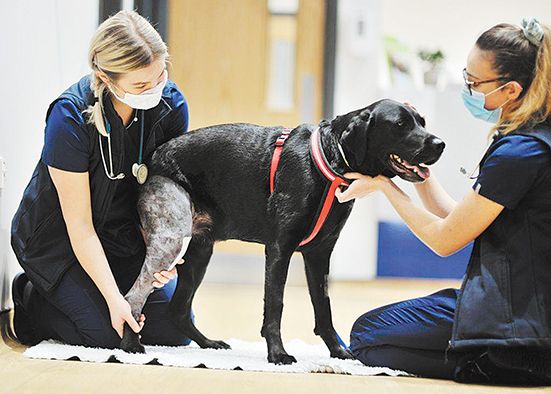Don’t get caught on the hop if your dog has knee injury
Don’t get caught on the hop if your dog has knee injury
4 January 2023

IT’S been a cold and wintry Christmas in Lecale. There has been ice on the roads and pavements making travelling — even walking — treacherous.
This is true for our four-legged friends, as well as ourselves. Here at Downe Vets we have seen an increase in lame dogs presenting at the clinic during the festive season.
One of the major causes of this lameness is cruciate ligament disease. You may notice this present in your dog as a hindlimb lameness making it painful for your pet to walk and run.
The cruciate ligaments — there are two of them, cranial and caudal — are present in the stifle (knee) of people and dogs. One of their jobs is to hold the two big bones (femur and tibia) of the knee joint together.
They stretch and relax as the knee bends while walking or running. They are remarkably resilient, given the stress they are put under during a lifetime of a dog running. However, sometimes these ligaments fray, and then snap. This process is known as cranial cruciate ligament (CCL) disease.
There have been many studies into the causes and treatment of this common condition in dogs. Some risk factors causing the disease include the dog being overweight and older. However, sometimes it is hard to pinpoint why the cruciate ligament has ruptured. Once it has ruptured though, the knee joint becomes unstable. The dog finds running painful and osteoarthritis of the knee joint develops. This process is irreversible.
Diagnosis of CCL injury involves a clinical assessment
by your vet and X-rays of the stifle joint. Your vet may also perform certain tests to see how the joint moves when your dog is sedated.
Treatment can be either surgical or medical. Surgical treatment is generally associated with better outcomes — ie your dog will return to running more quickly with surgery than without. However, like all surgeries, there is a complication rate. Medical treatment involves rest and pain relief. This tends to work a bit better with smaller, lighter dogs.
Unfortunately, once the cruciate ligament in one leg goes, the dog tends to put more weight on the “good” leg. This can result in the ligament going in that leg too, generally within six months to a year of the initial injury. Then the treatment cycle starts again.
Prevention is better than cure, as ever. But pretty much the best preventative measure owners can take is to keep their dog at a sensible weight. Again, check with your vet what this should be.
At Downe Vets we routinely weigh dogs on our health plan to ensure they are in a healthy weight range.
If you notice your dog has developed a limp, please do not hesitate to book an appointment for assessment. Call us on 028 4461 4225, visit www.downevets,com, or scan our booking link.


